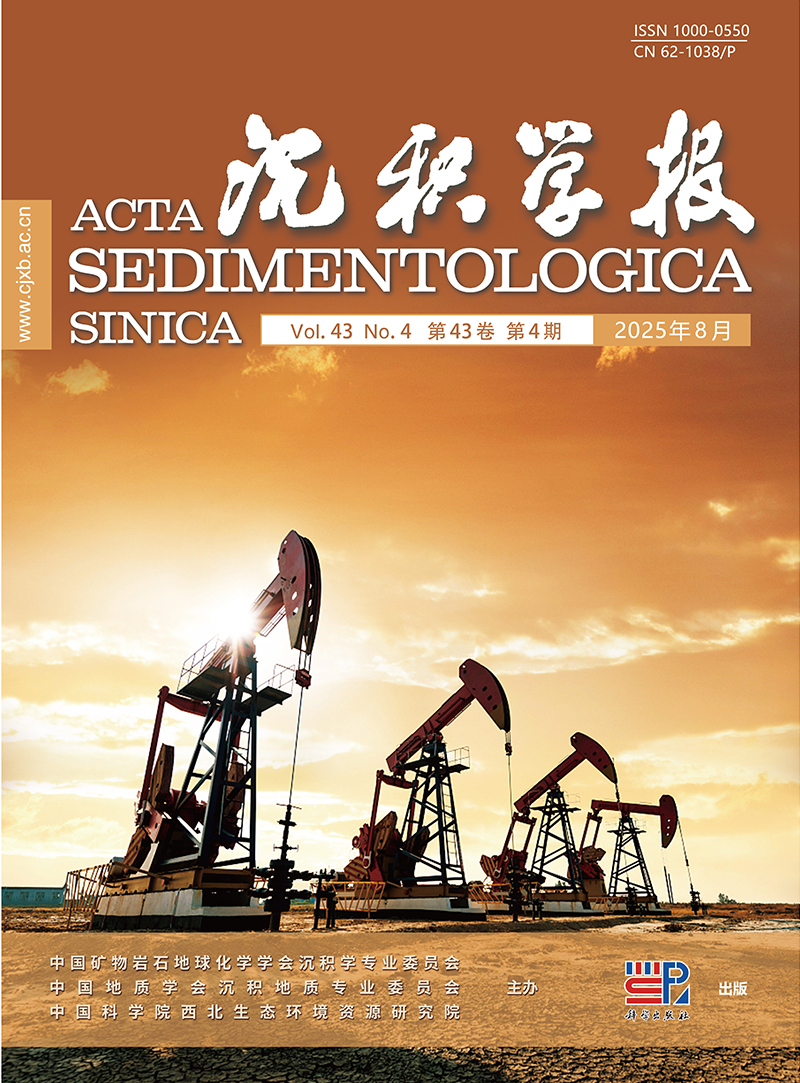HTML
-
源—汇概念自20世纪90年代末在“大陆边缘源—汇系统研究”提出并应用于沉积学以来[1],被广泛运用于地表动力学与沉积盆地充填分析等方面[2⁃3]。近年来随着多学科交叉支撑下源—汇系统研究的发展,物源分析手段从“定性”走向“定量”[4],在恢复源—汇过程及预测沉积物分布规律等方面均取得了一定进展[5⁃6]。相对于国际上“洋陆边缘源—汇系统”具有相对宏观和丰富的研究成果[7⁃9],我国在古老“源—汇”系统领域的研究仍处于初级阶段。源—汇研究在我国发展的前十年主要集中在控砂机制与对应的构造演化、地貌差异、物源供给等方面,在东部中新生代断陷湖盆或者现代沉积研究中取得了一定的成果[10⁃11]。随着碎屑锆石物源示踪在古地理重建中的普及,有学者尝试利用高精度U-Pb年龄对源—汇过程进行约束[12],但更多集中在峰值年龄组的对比溯源方面,且锆石定年数据通常受到测试成本与样品数目的限制,更具说服力的平面覆盖或垂向演化的年龄对比研究较为薄弱。因此,当前对于源—汇过程与盆山耦合关系的系统研究,缺乏基于大量数据的半定量—定量分析研究,仍处于以定性研究为主的阶段[10⁃11,13⁃15]。
鄂尔多斯盆地是我国形成历史最早、演化时间最长的沉积盆地之一,石炭至二叠期间在泛大陆拼合背景下完成了海陆转变的过程,前人着重关注这一时期的物源归属与沉积分异规律[14⁃15],并在砂体展布与控储成藏规律的研究上取得了一定进展[16⁃17]。其中山西组作为海陆转变的关键阶段[18],大部分研究更多聚焦在盆地中东部的页岩气藏、聚煤规律与致密砂岩气等方面[19⁃21]。而南部地区对物源体系的研究更多局限于简单的分区[22],对沉积特征的研究大多着重探讨内部的砂体发育规律[23]。目前南部地区所存在的源汇系统的影响范围、物源差异研究相对匮乏;北部物源与南部物源的交汇情况尚不明确;同时整个南部地区的构造背景差异及其控制下的古地理格局仍存在诸多争议,制约着鄂尔多斯地区南部下一步油气资源的勘探[24]。
鉴于此,本文以山西组为研究对象,结合基础沉积学与稀土元素、碎屑锆石等分析手段,系统划分鄂尔多斯地区南部源—汇系统,在此基础上恢复了鄂尔多斯地区南部的构造背景与物源性质,半定量—定量对比各源—汇系统单元要素差异,进而探讨多物源背景下源—汇系统特征及沉积充填过程,为该区古地理重建提供一定的理论指导。
-
鄂尔多斯地块是华北地台西南端的次级构造单元,经历了多次构造演化,整体沉积较为稳定,内部沉降缓慢,是一个多旋回克拉通沉积叠置盆地[14]。盆地所在的华北板块在晚古生代位于东冈瓦纳地区的多板块结合部位[25],其北部为古亚洲洋域,南部为秦岭—祁连造山带与古特提斯洋盆相接(图1a),在古特提斯构造域周缘存在祁连造山带、秦岭造山带、走廊过渡带等众多构造单元(图1b);祁连造山带可分为北祁连构造带、中祁连地块和南祁连构造带三个地质体,其中,北祁连构造带位于中祁连地块与走廊过渡带之间。作为中央造山带的重要组成部分,秦岭造山带可分为东、西两段并分别与大别—苏鲁造山带和祁连—昆仑造山带相连[26]。古生代以来鄂尔多斯地区南部构造—沉积演化主要受古特提洋俯冲—碰撞过程的控制[27],早二叠世秦祁造山带受南侧特提斯洋盆俯冲开始隆升造山,与华北板块南缘共同为南部地区供源;至中二叠世,伴随着华北陆块南缘受古特提斯洋的俯冲抬升,秦岭造山带强烈挤压隆升并持续为南部地区供源(图1c),海水逐渐退出,完成了由海陆过渡向陆相沉积转换的过程。

Figure 1. (a) 300 Ma paleogeographic map of the North China Block (modified from reference [25]); (b) geotectonic location map of the southern North China Plate; (c) tectonic location map of the study area (paleoflow data modified from references [14⁃15]); (d) vertical strata distribution (strata ages modified from reference [30])
-
鄂尔多斯地区在早古生代晚期具有1亿多年的沉积间断,至晚古生代石炭纪中期重新开始沉降,并接受沉积,总体上延续了早古生代晚期西、南两侧凹陷,中部隆起的古构造—沉积格局[28]。在中央古隆起的东西两侧,发育滨浅海和潮坪相沉积;二叠纪早期,由于两侧海侵面积不断扩大,海水将中央古隆起覆盖,之后随着南北构造—沉积差异进一步增大,在山西组沉积阶段,华北板块与蒙古板块的碰撞导致了北部蒙古—长白—兴安褶皱带、南部秦岭—祁连—昆仑褶皱带的形成,并使其逐渐被抬升为陆地,海水迅速从东西两侧退却,由海相转为陆相,揭开陆相沉积的序幕,从而使干旱气候再次出现。此时期盆地边界南界大致沿兰州—丹凤—洛南一带分布,北界至兴蒙造山带,东界可延伸至华北板块边界处,西界为阿拉善地块西侧[29]。
在晚古生代研究区从下往上依次沉积了海相沉积为主的上石炭统本溪组(C2b),海陆过渡沉积体系为主的下二叠统太原组(P1t)、山西组(P1s),以及陆相沉积为主的中二叠统石盒子组(P2sh)等[30],沉积范围逐渐扩大。此次研究的目的层山西组是当前鄂尔多斯盆地进行天然气勘探的重要层位(图1d),该时期总体地层厚度表现为南北近物源区较薄,向沉积区逐渐增厚的特征,东西向无明显厚度差异(图1c)。山西组上覆于太原组之上,与太原组呈整合接触且连续沉积,其底部为“北岔沟砂岩”,发育大套冲刷面。下石盒子组底部“骆驼脖子砂岩”为上覆地层,常作为划分下石盒子组与山西组的标志层。相较于同为海陆过渡沉积的太原组,山西组岩层厚度较大,煤层减少、砂岩增多,广泛分布暗色泥页岩,主体岩性为粉砂岩、深灰—灰黑色泥岩及中细砂岩互层出现,中下部常有砂岩发育,但其稳定性较差,厚度变化大。在鄂尔多斯地区南部山西组以曲流河三角洲和滨浅海—滨浅湖过渡相沉积为主。三角洲沉积物以灰白色—浅灰色细砂岩为主,滨浅海—滨浅湖沉积物主要为深灰色—灰黑色砂质泥岩[31]。
1.1. 区域构造背景
1.2. 地层及沉积背景
-
本研究用于全岩微量、稀土元素分析和锆石U-Pb年代学研究的样品源自鄂尔多斯地区南部6条剖面和31个钻井岩心(具体样品点位置见图1c)。为确保实验结果的代表性与可靠性,研究所选取的样品尽可能覆盖整个研究区。在实际采样过程中,优先选择风化蚀变和成岩作用弱的样品,以保证所选样品的可靠性。全岩微量、稀土元素分析在四川省科源工程技术测试中心进行,采用高分辨率等离子体质谱仪(HR-ICP-MS)完成,其分析精度优于5%;锆石U-Pb定年在廊坊诚信地质服务有限公司完成,采用LA-MC-ICP-MS激光剥蚀系统进行U-Pb同位素测定。具体的仪器配置与实验方法流程可参见文献[32]。
-
稀土元素是识别物源的重要手段之一,沉积区样本与物源区母岩配分模式曲线基本形态特征的相似性对比是判定源—汇系统范围的常用方法。研究采用Bonyton[33]提出的球粒陨石标准化进行处理,并获取不同源—汇系统的∑LREE、∑HREE、LREE/HREE、δEu和δCe等参数。∑LREE和∑HREE分别代表轻、重稀土元素含量和,LREE/HREE值为轻、重稀土元素的比值,能够反映样品轻、重稀土的分异程度[34]。同一类岩石中,若该值较大,说明轻稀土元素相对富集,重稀土元素相对亏损。δEu和δCe表示Eu和Ce的异常程度,当值大于1时为正异常,小于1时为负异常,等于1时为正常。
锆石U-Pb法定年广泛运用在大型沉积盆地源—汇系统研究中[35⁃36]。该方法可约束地层年龄,识别潜在物源区、揭示母岩性质,确定造山带抬升剥露的持续时间和速率[37],重建物源区构造演化史[38]。通过对比碎屑矿物年龄分布与潜在物源区母岩年龄,可用于寻找潜在物源区,判断沉积物搬运路径,恢复构造运动对盆地充填的控制作用[39]。Th/U值与锆石年龄图解被运用于母岩的基本判别,一般情况下,Th/U大于0.4表现为岩浆成因,Th/U小于0.1表现为变质成因[40]。本研究锆石年龄计算以及谐和图的绘制采用Isoplot完成,大于1.0 Ga的年龄采用207Pb/206Pb年龄值,小于1.0 Ga的年龄选用206Pb/238U年龄值,其中谐和度介于90%~110%的锆石被用来统计年龄以生成概率密度分布函数曲线(PDF)[41]进行视觉分析。此外,研究使用非矩阵多维标度MDS(Multi-dimensional scaling)进行批量锆石数据相似(相异)定量分析[42],它是利用数据之间的相似性对数据进行成分分析,将多维空间中的数据集降维简化投影在低维空间内,并以线连接点的方式呈现,对比研究区样品之间锆石U-Pb年龄分布的相似/相异度,能够较好区分具有不同源区特征的沉积物,以确定各源—汇系统交汇范围及其相关物源主次贡献度。绘图采用IsoplotR平台[43],通过计算MDS距离生成评估拟合好坏的一种“置信”参数[42],并形成折线图。连接各样品之间的线条代表样品的相近/相似性,样品之间的实线代表两者最为相近,而样品之间的虚线表明样品之间具有次相关关系,线长与相似性成反比关系。
-
沉积岩中微量元素的迁移富集主要受其自身物理化学性质、形成环境以及风化作用过程等因素控制,其含量对沉积环境变化有较高的敏感度,可作为沉积背景识别的重要指标,为沉积物源及古环境恢复和大地构造背景的变迁提供依据[44]。本文主要根据La-Th-Sc、Th-Co-Zr/10、Th-Sc-Zr/10构造背景三角判别图,区分大洋岛弧、大陆岛弧、活动大陆边缘和被动大陆边缘的源区构造背景及沉积环境[45⁃46]。碎屑锆石年龄数据亦可用于约束物源区的构造背景[47⁃48],研究将锆石年龄数据利用累积概率分布函数图解(CDF)验证物源相似性并判别其主要构造背景[47]。具体原理如下:当CA-DA(碎屑锆石结晶年龄—地层沉积年龄)值在5%累计比例下,年龄差值大于150 Ma,代表沉积背景为拉张伸展环境;反之,则进一步观察在30%的累计比例下的CA-DA值,当CA-DA大于100 Ma代表碰撞挤压背景,CA-DA小于100 Ma则为汇聚造山背景。
-
沉积(后)坡角由沉积物堆积后形成,反映其沉积方式,一般从其沉积构造或纵向剖面结构得到,而沉积前的地形坡角大小随地形而改变。此外,沉积体系的形成通常有多个期次,前一期的沉积后坡角是后一期的沉积前(古地形)坡角,它不仅是对沉积体系的剖面结构进行分析的关键,同时也是层序地层划分级次的主要判别依据。大地构造背景控制下的古地形特征,直接影响其沉积相类型及特征,因此古地形分析是“源—汇”系统研究的重要部分[49]。鄂尔多斯盆地山西组内不存在其他剥蚀现象,在后期构造演化中保存较好,地层完整,因此不需要剥蚀量恢复,仅需要通过压实校正来恢复地层原始厚度。本论文结合前人对南部地区古流向的测量结果,选取顺物源区方向的井位,采用压实模拟经验图版计算地层古厚度方法[50⁃56](图2),对研究区山西组原始厚度进行分析,从而计算出该沉积时期的地形坡度。具体步骤为:首先计算出砂地比,结合图版得到古厚度,再根据两口井之间的距离和古厚度差进行地形坡度的计算。

Figure 2. Sedimentary basin compaction simulation method paleothickness restoration chart[49]
2.1. 样品来源与分析
2.2. 数据方法解释
2.2.1. 源—汇系统判别
2.2.2. 构造背景判断
2.2.3. 古厚度(坡度)恢复
-
研究区域轻、重稀土元素分异程度明显,总体表现为轻稀土元素相对富集,重稀土元素相对亏损,配分模式曲线呈左高右低的“右倾型”模式,Ce、Eu元素均具有不同程度的负异常特征。所有样品在配分模式曲线形态内无明显差异,因此,研究采用统计学方法(聚类分析与相关性分析)对所有稀土样品结果进行分析,环形聚类热图(图3a)表明所有样本在东西向上具有显著的分异性。结合前人对秦岭、祁连造山带样品稀土元素特征的研究,与研究区样品点的稀土配分模式进行相似性对比筛选,结果表明研究区共可识别出以下3类稀土配分模式。(1)宜川—富县地区:∑LREE均值为209.39,∑HREE均值为61.43,轻、重稀土元素之比LREE/HREE为2.66~4.65,平均值为3.50,分异程度较明显,表明轻稀土元素较为富集。δEu均值为0.79,Eu负异常且严重亏损;δCe均值为1.05,Ce轻微正异常;(2)耀县—洛川地区:∑LREE的均值为226.91,∑HREE均值为54.16,LREE/HREE为3.60~5.12,平均值为4.34,轻重稀土发生显著分异,轻稀土元素富集。δEu均值为0.75,Eu负异常且严重亏损;δCe均值为1.03,Ce无负异常;(3)平凉—环县地区:∑LREE的均值为484.43,∑HREE均值为125.89,LREE/HREE为3.52~4.21,平均值为3.85,呈现出较强的分异性,表明轻稀土元素相对富集。δEu均值为0.60,Eu负异常且严重亏损,δCe均值为0.99,Ce负异常不明显。

Figure 3. (a) Ring cluster heat map data of REE (drawn using <https://www.chiplot.online>); (b) distribution of REEs in different source to sink systems of the Shanxi Formation in the study area
基于对样本与源区稀土配分模式特征的差异性对比得出,研究区存在3个方向的物源区(图3):宜川—富县地区样品稀土元素配分模式与北秦岭东段涝峪地区花岗闪长岩[57]稀土元素配分模式具有较强的一致性,推测研究区物源来自北秦岭东段(北秦岭东段源—汇系统);耀县—洛川地区样品稀土元素配分模式与北秦岭西段麟游地区基底[57]稀土元素配分模式具有较强的一致性,推测研究区物源来自北秦岭西段(北秦岭西段源—汇系统);平凉—环县地区样品稀土元素配分模式与北祁连海原地区云母片岩[58]稀土元素配分模式具有较强的一致性,推测研究区物源来自北祁连(北祁连源—汇系统)。
-
研究对鄂尔多斯地区南部二道沟等8处采样点(位置见图1c)的665个锆石测年数据进行图件分析,相关样品的年龄概率密度分布曲线如图所示(图4a),所有年龄数据清晰地记录了新太古代以来华北地区发生的最主要的构造—岩浆事件。根据各数据所处年代可划分为3大主要的年龄区间(图4b),分别为323~251 Ma(晚古生代年龄)、550~350 Ma(早古生代年龄)、2 800~1 500 Ma(新太古代—中元古代年龄)。根据稀土配分模式确定的最主要物源归属来看,各源—汇系统之间的锆石年龄呈现出一定的差异,结果如下(图4c):(1)北秦岭东段源—汇系统内有12%~19%的锆石年龄出现在323~251 Ma内,3%~9%的锆石年龄在550~350 Ma内;其余74%~85%的锆石年龄介于2 800~1 500 Ma,具有~2 500 Ma、~1 800 Ma两个明显的年龄峰,所有锆石年龄Th/U比值介于0.03~3.45,其中比值大于0.4的占81.1%;(2)北秦岭西段源—汇系统在323~251 Ma内的锆石年龄占比较低,仅为6%~8%,1%~3%的锆石年龄介于550~350 Ma;介于2 800~1 500 Ma的锆石年龄占比为三大源—汇系统最高,可达89%~91%,具有~2 500 Ma的年龄峰,所有锆石年龄Th/U比值介于0.06~2.72,比值大于0.4的占80.6%;(3)北祁连源—汇系统在323~251 Ma内的锆石年龄占比略有增加,为9%,有4%的锆石年龄在550~350 Ma内;其余87%的锆石年龄均介于2 800~1 500 Ma,具有~2 500 Ma、~1 800 Ma两个明显的年龄峰,所有锆石年龄Th/U比值介于0.01~18.09,其中比值大于0.4的占78.1%。三大源—汇系统主要锆石年龄峰值区间相同,表明南部地区主要物质来源组成接近,但在各年龄区间含量中存在差异,此外,碎屑锆石Th/U多数大于0.4,表明样品所有锆石普遍具岩浆成因特点。
-
利用La-Th-Sc、Th-Co-Zr/10、Th-Sc-Zr/10判别图对鄂尔多斯地区南部沉积岩样分析结果进行投点,以明确不同物源区构造背景,三类构造判别图解结果基本一致(图5):(1)北秦岭东段源—汇系统在主动大陆边缘和被动大陆边缘的区域与大陆岛弧均有显示,但总体以主动大陆边缘为主(图5a);(2)北秦岭西段源—汇系统以主动大陆边缘与大陆岛弧为主,偶见落入被动大陆边缘环境的样品点(图5a,b);(3)北祁连源—汇系统主要表现为主动大陆边缘与被动大陆边缘的混合背景,偶见大陆岛弧背景样品点落入(图5a,b)。图5c大部分点都落在了主动大陆边缘区域,少量落在了大陆岛弧区域。综上研究认为鄂尔多斯地区南部各物源区构造背景以主动大陆边缘为主,被动大陆边缘次之。
碎屑锆石累计年龄概率曲线图显示(图6):南部地区所有锆石样品(二道沟、苏234、城探2、口镇、洛2、宜24、韩城、河津)前5%年轻的碎屑锆石结晶年龄与地层沉积年龄[28]之差都小于150 Ma,前30%年轻的碎屑锆石结晶年龄与地层沉积年龄之差均大于100 Ma,表明整个南部地区在山西组沉积期均以碰撞挤压背景(B类型)为主,南部不同物源体系构造活动相对一致,均表现为碰撞挤压背景下的主动大陆边缘,并未出现明显的造山作用。
-
通过选取南部地区山西组近东西向的10口钻井与两处剖面,对该区域砂体的横向展布特征进行分析(图7a),可识别出3大源—汇系统的物源通道及彬3井、延625井两处分水岭。综合前文中对源—汇系统边界的刻画,参考前人对鄂尔多斯地区沉积体系的认识[28,63],建立了如图7b所示的南部地区沉积相平面特征展布图,研究认为山西组沉积时期研究区主要为曲流河三角洲沉积体系,广泛发育三角洲平原和三角洲前缘两种亚相,三大源—汇系统分别发育:平凉二道沟三角洲(北祁连物源体系)、淳化口镇三角洲(北秦岭西物源体系)、韩城三角洲(北秦岭东物源体系)。各源汇系统内地层厚度具有明显差异,整体呈西厚东薄的特点,具体特征如下:(1)北秦岭东段源—汇系统内具有早期相对贫砂晚期富砂的特征,砂体连通性较好,单河道砂体厚度介于2~7 m,因河道侧向迁移,叠置河道宽度逐渐增大;在延704井处砂体最为发育,为主河道部位,属于三角洲平原到前缘过渡带;(2)北秦岭西段源—汇系统处于东西沉积体系交汇区,单砂体厚度较大,其内部复合砂体由多期次单砂体垂向叠置而成,表现为早期富砂晚期减少的特征,砂体横向连通性中等,在陇34井处沉积厚度与单砂体厚度均为最大,单砂体厚度可至17 m;(3)北祁连源—汇系统砂体表现为西多东少的特征,砂体连通性中等,单砂体厚度介于3~5 m,富砂带表现为向东迁移,为多期中—薄层河流三角洲前缘沉积。

Figure 7. (a) Erdaogou⁃Jushuihe sandy sediments connection diagram (A⁃A΄); (b) sedimentary facies map of southern region (modified from references [28, 63])
研究选取顺物源方向11口井/剖面,重点对典型标志层北岔沟砂岩所在的山2段的现今厚度数据以及砂地比含量进行了统计,恢复三大最主要三角洲沉积体系的古坡度(表1)。结果表明:(1)宜川—富县地区(北秦岭东段源—汇系统)南北向顺物源方向平均古坡度大致为0.048°;(2)耀县—洛川地区(北秦岭西段源—汇系统)平均古坡度大致为0.040°;(3)平凉—环县地区(北祁连源—汇系统)平均古坡度大致为0.045°。整体地形平缓,水动力较弱。
范围 平凉一环县地区 耀县一洛川地区 宜川一富县地区 位置 二道沟 代参1 陇26 庆探1 淳2 彬1 城探2 三眼桥 宜5 新富6 富古1 现今厚度/m 22.00 57.90 52.00 54.00 35.00 37.10 46.00 18.00 29.40 52.00 54.60 砂岩厚度/m 15.00 38.88 26.00 17.00 20.25 21.00 16.50 12.49 12.25 25.37 17.00 砂地比 0.682 0.672 0.500 0.315 0.579 0.566 0.359 0.694 0.417 0.488 0.311 恢复古厚度/m 41 98 109 141 71 74 115 32 69 110 126 距离/m 60.805 36.017 28.839 81.260 30.227 52.007 34.787 25.660 角度/(°) 0.054 0.017 0.064 0.002 0.078 0.041 0.068 0.036 Table 1. Recovery of ancient slope of delta in southern region
3.1. 稀土配分模式特征
3.2. 锆石年代学特征
3.3. 源区构造背景特征
3.4. 古坡度及沉积体系特征
-
源—汇系统的空间分异性是源区、陆源碎屑供给、水动力过程和颗粒性质共同作用的结果[64⁃65]。稀土元素在经过搬运沉积后仍具有很强的继承性,极大程度地代表着物源区属性,尽管研究区三大源—汇系统均表现为轻稀土富集、重稀土亏损的共性,但结合具体数据可知北秦岭西段轻、重稀土元素分馏程度明显高于其余两大源—汇系统,推测为在沉积过程中稀土元素的分异程度受到混合、均化等作用的影响[66]。此外,南部地区在早二叠世之前具有较多的火山活动[14],而火山碎屑对重稀土具有一定稀释作用,会导致轻、重稀土元素分异更加显著,因此秦岭造山带东段较高的LREE/HREE可能指示了物源区在此时更强烈的构造运动,从而为研究区带来了充足的火山碎屑物质。结合研究区可能物源区的锆石年龄曲线(图4),可得秦岭—祁连造山带与华北克拉通基底不具有晚古生代(323~251 Ma)的锆石年龄,结合前人在研究区以北样品的锆石年龄研究结果[67⁃68],我们认为其主要成因与秦岭古洋盆内勉略洋向北的俯冲作用密切相关,该俯冲作用引发的弧—陆碰撞事件,进一步催生了相应的火山岩以及花岗岩事件[69⁃70],该年龄在北秦岭—北祁连—东昆仑中的锆石年龄中均有出现(图4a)。考虑到东昆仑造山带与南部地区距离过大,位置更近的南秦岭造山带不具有早古生代年龄,且其年龄曲线特征与最西端的二道沟样品差异较大,因此不认为研究区具有来自该处的物质。早古生代年龄的物源应该均出自祁连造山带与北秦岭造山带。此外,~1 800 Ma、~2 500 Ma的新太古代—中元古代年龄贡献通常被认为是来自华北克拉通基底[69]。图4b显示,在北秦岭东、西段源汇系统内的样品中,323~251 Ma的年龄与500~400 Ma的年龄占比均具有东高西低的特点,而~1 800 Ma、~2 500 Ma年龄占比与之相反。表明在此时期北秦岭东段的供源能力更强,其隆升程度应大于华北克拉通南缘;而在北秦岭西段源汇系统中,华北克拉通南缘隆升程度更高,为研究区提供更多物源;向西至北祁连源汇系统,基底供源能力略有减弱,北部造山带与北祁连造山带的供源略有增强。华北克拉通南缘基底为研究区提供了74%~91%的物质来源,是整个研究区最主要的物源。北部造山带物源在所有样本里均有出现,但东侧占比更高、西侧次之,中部最低,表明在山西期北部中亚造山带物源实际已影响全区,其中在东侧延伸范围更大。古坡度结果表明,研究区整体地形平缓,具有中间较缓、两侧略陡的特征,水动力较弱,因此在南部地区以曲流河三角洲沉积为主,其内部砂体以水下分流河道砂体为主。在北秦岭西段源汇系统内,纵向上河道逐渐加宽,单河道砂体厚度减小,砂体多向两侧尖灭于泥岩内,表明三角洲逐渐向水下延伸,水动力条件减弱,供源减小,以三角洲前缘沉积为主;而北祁连源—汇系统与北秦岭东段源—汇系统单砂体厚度较小,但多期叠置发育,且在平面内具有较强的连通性,以三角洲平原向前缘过渡为主。此外,在三大源汇系统中北秦岭东段源—汇系统平均古坡度角最大,也充分表明其源区(北秦岭东段)具有更高的隆升程度,受到更强烈的剥蚀作用。
-
为了进一步进行直观对比不同源—汇系统的锆石U-Pb数据,对上述锆石年龄数据进行非矩阵多维标度(MDS)统计分析以进一步明确其相关性(图8)。所有样品在MDS图中具有显著的分异程度。其中河津、洛2、宜24锆石年龄成分高度相似,表现出强亲缘关系,结合前文结果可认为来自同一源区,推测以北秦岭东段供源为主;口镇与城探2具有强亲缘关系,应共同接受北秦岭西段供源,洛2与口镇、城探2均表现出一定的相似性,可推测洛2处于北秦岭东、西段两大源汇系统的交汇区,但相较更倾向于北秦岭东段供源;苏234与二道沟在图中表现出强相似性,可认为二者主要接受来自北祁连的物源。此外,韩城与二道沟也表现出一定的相似性,考虑到韩城与二道沟的实际距离相差较远,二者之间的弱相似性应仅局限于部分年龄组合的相似,但与共同物源无关。在所有南部样品点内,口镇与城探2井样品离散于其余样品点,研究认为这主要与其位置偏南,极少受到北部中亚造山带的影响有关。
4.1. 源—汇系统特征差异
4.2. 不同源—汇系统间的交互影响
-
综合上述构造、地貌、沉积等单元要素特征,本文从板块级别尺度建立了鄂尔多斯地区及周缘的构造—沉积模式(图9)。从板块尺度来看,山西组沉积时期所在的晚古生代处于潘基亚超大陆聚合的关键阶段,在此阶段中北半球多个板块(华北、波罗的、西伯利亚、塔里木、哈萨克斯坦)向中纬度地区汇聚,包括华北板块在内的多个板块在晚古生代具有顺时针漩涡运动的轨迹,在汇聚与旋转的过程中板块间洋盆逐渐闭合[71],致使北部地区造山作用逐渐增强。南部地区受秦岭—祁连造山带的影响,微量元素投点及锆石累积曲线均表现出以碰撞挤压为主的主动大陆边缘背景,反映南北秦岭地体之间的勉略洋盆持续的向北俯冲[72]。4.1小节结论表明,秦岭造山带东段供源能力强,为研究区输送了更多的火山碎屑物质,故其隆升程度应大于华北克拉通南缘以至于受到更强的剥蚀作用,因此研究推测秦岭造山带东段在山西组沉积期具有更高的地形,秦岭造山带的隆升程度应具有东高西低的特征(图9),这与古坡度结果相一致。祁连造山带隆升程度高于北秦岭西侧但低于北秦岭东侧,该差异结果应当与上述华北板块顺时针旋转导致勉略洋盆俯冲过程中东西向的相对强弱程度有关[71⁃72]。在上述汇聚、旋转过程的持续影响中,整个华北陆块被持续抬升,以往研究中提及的“北高南低”的结论可认为是古亚洲洋、勉略洋俯冲/碰撞的先后顺序以及强弱程度差异所致[73]。受区域性挤压作用,鄂尔多斯地区形成以三角洲沉积体系为主的海陆过渡环境,山西组初期海水从东南部迅速退却,在现今山西—河南局部地区残余潮坪—开阔台地等海相沉积,至晚期正式进入陆相沉积[74]。山西组沉积期在全球尺度内属于冰期至间冰期过渡,在鄂尔多斯地区南部三角洲相与滨浅海至滨浅湖的过渡为山西组的主要沉积环境[14,63]。早二叠世以来大气中CO2含量逐渐回升,至290 Ma后CO2含量快速增加,气温回升[75],在晚古生代后半阶段(305~270 Ma)潘基亚超大陆赤道区域具有长时间的干旱化趋势,且自西向东扩张作用于华北板块所在的东冈瓦纳地区,使得鄂尔多斯地区在山西组沉积期具有温暖潮湿、但逐渐向炎热干旱过渡的趋势[76]。该条件有利于植物快速生长,大量的植物起到很好的水土固结作用,一定程度阻挡了物源供给,使得河流的侧向迁摆动力不足,水动力条件较弱,坡度整体较小,发育广泛的曲流河三角洲相[56]。而此时来自北部的三角洲体系规模不断变大,局部已经达到延长—定边地区,与南部三角洲沉积体系相交汇,古地形坡度的陡缓在很大程度上决定着沉积时水动力的强弱:坡度越大,水动力越强,则其控制的三角洲面积越小,因此在宜川—富县地区发育的三角洲延伸规模最小。另一方面从锆石年龄占比结果来看,该区域所对应的北秦岭东段源—汇系统接受了更多的北部中亚造山带物质,北部物源的推进在一定程度上制约了南部三角洲的发育规模。正南部耀县—洛川三角洲平面展布最广,而西南部平凉—环县三角洲延伸至泾川—环县以西地区,展布范围中等。总体来看,北秦岭东段源汇系统早期贫砂晚期富砂,以三角洲平原到前缘过渡带为主,三角洲延伸规模最小;北秦岭西段源汇系统则早期富砂晚期贫砂,以三角洲前缘沉积为主,三角洲延伸范围最广;而北祁连源汇系统砂体垂向上厚度较为均一,但随着供源增强横向展布范围扩大,以三角洲平原向前缘过渡沉积为主。
-
(1) 鄂尔多斯地区南部山西期可识别北祁连、北秦岭西与北秦岭东三大源—汇系统,均表现为Eu严重亏损,其中北祁连源—汇系统轻稀土元素相对富集,δEu均值为0.60,顺物源方向平均古坡度约为0.045°;北秦岭西段源—汇系统轻稀土元素明显富集,δEu均值为0.75,顺物源方向平均古坡度约为0.040°;北秦岭东段源—汇系统轻稀土元素较为富集,δEu均值为1.05,顺物源方向平均古坡度约为0.048°。
(2) 锆石年龄占比显示华北克拉通基底为最主要物源,其次为北秦岭、北祁连造山带与中亚造山带物源。中亚造山带在山西期实际已影响全区,其中在北秦岭东段源—汇系统占比更高。洛2井附近为北秦岭东、西段物源的交汇区域。
(3) 南部地区山西组总体主要为主动大陆边缘环境,被动大陆边缘次之。伴随着勉略洋盆向北俯冲、板块持续汇聚的大地构造背景,北秦岭东段隆升剥蚀作用更强烈,沉积物供给量更大,北祁连造山带隆升程度中等,北秦岭西段隆升程度最低。
(4) 北秦岭东段源汇系统在山西晚期相对富砂,以三角洲平原到前缘过渡沉积为主,延伸规模最小;北秦岭西段源汇系统表现为早期富砂晚期贫砂,以三角洲前缘沉积为主,延伸范围最广;北祁连源汇系统则以三角洲平原向前缘过渡沉积为主,延伸范围适中。












 DownLoad:
DownLoad:







